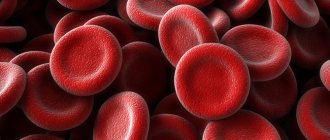Acute leukemia is a cancer of the blood and hematopoietic organ - the red bone marrow, in which normal leukocytes are gradually replaced by immature (blast) cells that are unable to perform their function. As a result, the patient develops inflammation and bleeding of internal organs, which significantly worsens his condition, immunity sharply decreases, and the nervous system is affected. In the absence of qualified medical care, an unfavorable outcome inevitably occurs. The disease is characterized by high aggressiveness: mutated cells quickly spread throughout the body, and their number grows at high speed.
Types of disease
Oncohematologists, depending on the nature of the cell pathology, distinguish two main types of acute blood leukemia.
- Lymphoblastic. Accounts for approximately 15-20% of cases. First, malignant cells affect the bone marrow, then spread to the lymph nodes, thymus gland and spleen, and then throughout the body. A characteristic feature is that mutated cells lack lipids, esterase, and peroxidase. It most often develops in children aged from one to six years and in adults after forty years. In turn, it is divided into two types: B-form with a favorable prognosis for a third of adults and two-thirds of sick children, and T-form with an extremely severe course and a sad outcome.
- Myeloblastic. The disease usually develops in adulthood and affects men and women equally. The treatment prospects are quite optimistic: partial remission can be achieved for 80% of patients, complete recovery occurs in at least 20%.
The full classification of acute leukemia includes many subtypes that differ in morphological, genetic and other characteristics that require specific treatment.
How common is acute leukemia in adults?
In 2002, 8149 cases of leukemia were identified in Russia. Of these, acute leukemia accounted for 3257 cases, and subacute and chronic leukemia - 4872 cases.
It is estimated that 33,440 new cases of leukemia will be diagnosed in the United States in 2004. Approximately half of the cases will be acute leukemia. The most common type of acute leukemia in adults is acute myeloid leukemia (AML). At the same time, 11,920 new cases of AML are expected to be identified.
During 2004, 8,870 patients may die from acute leukemia in the United States.
The average age of patients with acute myeloid leukemia (AML) is 65 years. This is a disease of older people. The chance of developing leukemia for a 50-year-old person is 1 in 50,000, and for a 70-year-old it is 1 in 7,000. AML occurs more often in men compared to women.
Acute lymphoblastic leukemia (ALL) is more often diagnosed in children than in adults, and is most common before the age of 10 years. The probability of being diagnosed with ALL in a 50-year-old person is 1 in 125,000, and for a 70-year-old it is 1 in 60,000.
African Americans are 2 times less likely to develop ALL than the white population of America. Their risk of developing AML is also slightly lower than that of the white population.
With AML and ALL in adults, long-term remission or recovery can be achieved in 20-30% of cases. Depending on certain features of leukemia cells, the prognosis (outcome) of patients with AML and ALL may be better or worse.
Symptoms
The first signs by which one can suspect the onset of the disease are the same for all its forms.
- Noticeable weight loss not associated with food restriction or exercise.
- Fatigue, deterioration in general health.
- Constant weakness, apathy, drowsiness.
- A feeling of heaviness after eating, often concentrated in the left hypochondrium and independent of the amount and calorie content of what was eaten.
- Frequent infectious diseases.
- Increased sweating, especially at night.
- Increased body temperature.
As malignant cells grow in the blood, the symptoms of acute leukemia become more pronounced.
- Pale skin, shortness of breath due to lack of oxygen carried by the blood, anemia.
- Frequent bleeding from the nose and gums, bruising on the skin and mucous membranes, in women - heavy periods.
- Dysfunction of the affected internal organs with its own specific manifestations.
- Severe pain in bones and joints.
- Increased size of the spleen and liver.
- Constant swelling of the hands and face.
Clinical signs are not differentiated in accordance with the classification of acute leukemia, so the form of the disease can only be determined using laboratory tests.
Leukemia
Leukemia is a malignant disease in which the process of hematopoiesis in the bone marrow is disrupted. As a result, a large number of immature leukocytes enter the blood, which cannot cope with their main function - protecting the body from infections. Gradually, they displace healthy blood cells and also penetrate various organs, disrupting their functioning.
Blood cancer is one of the most common cancers that occurs in both children and adults. The prognosis of the disease depends on many factors: the type of leukemia, the patient’s age, and concomitant diseases. Over the past decades, methods for effective treatment of leukemia have been developed and are constantly being improved.
Synonyms Russian
Leukemia, leukemia, blood cancer.
English synonyms
Leukemia, leucosis, bloodcancer.
Symptoms
Symptoms of myleukemia can develop acutely or gradually. They are nonspecific, depend on the type of leukemia, and in the initial stages may resemble the flu or other infectious disease.
Symptoms of leukemia are:
- frequent infectious diseases;
- fever;
- weakness, malaise;
- frequent prolonged bleeding;
- hematomas, hemorrhages on the skin and mucous membranes;
- stomach ache;
- swollen lymph nodes;
- causeless weight loss;
- headache.
General information about the disease
All blood cells - leukocytes, erythrocytes, platelets - are formed in the bone marrow - a specific hematopoietic tissue that is located in the pelvic bones, sternum, vertebrae, ribs, and long tubular bones. It contains stem cells, which give rise to all blood cells. During the process of division, lymphoid and myeloid stem cells are first formed. Lymphoblasts are formed from lymphoid stem cells, and myeloblasts are formed from myeloid stem cells, as well as precursors of erythrocytes and platelets. Leukocytes are produced from lymphoblasts and myeloblasts. Blasts differ from mature leukocytes in structure and function and must undergo a series of successive divisions during which increasingly specialized precursor cells are formed. After the last division, mature, functional blood cells are formed from the precursors. Thus, lymphocytes (a type of leukocyte) are formed from lymphoid stem cells, and erythrocytes, platelets and other types of leukocytes (neutrophils, basophils, eosinophils and monocytes) are formed from myeloid stem cells. These are mature blood cells capable of performing their specific functions: red blood cells deliver oxygen to tissues, platelets provide blood clotting, and leukocytes provide protection from infections. After completing their task, the cells die.
The entire process of division, death and maturation of blood cells is embedded in their DNA. When it is damaged, the process of growth and division of blood cells, mainly leukocytes, is disrupted. A large number of immature leukocytes enter the blood, unable to perform their function, and as a result, the body cannot cope with infections. Immature cells divide very actively, live longer, gradually displacing other blood cells - red blood cells and platelets. This leads to anemia, weakness, frequent prolonged bleeding, and hemorrhages. Immature leukocytes can also penetrate other organs, disrupting their function - the liver, spleen, lymph nodes, and brain. As a result, the patient complains of pain in the stomach and head, refuses to eat, and loses weight.
Depending on what type of leukocytes is involved in the pathological process and how quickly the disease develops, the following types of leukemia are distinguished.
- Acute lymphoblastic leukemia is a rapidly developing disease in which more than 20% of lymphoblasts appear in the blood and bone marrow. This is the most common type of leukemia and occurs in children under 6 years of age, although adults are also susceptible.
- Chronic lymphocytic leukemia progresses slowly and is characterized by an excessive amount of mature small round lymphocytes in the blood and bone marrow, which can penetrate the lymph nodes, liver, and spleen. This type of leukemia is typical for people over 55-60 years of age.
- Acute myeloblastic leukemia - with it, more than 20% of myeloblasts are found in the blood and bone marrow, which continuously divide and can penetrate other organs. Acute myeloblastic leukemia most often affects people over 60 years of age, but it also occurs in children under 15 years of age.
- Chronic myelocytic leukemia, in which the DNA of the myeloid stem cell is damaged. As a result, immature malignant cells appear in the blood and bone marrow along with normal cells. Often the disease develops unnoticed, without any symptoms. Chronic myeloid leukemia can occur at any age, but people aged 55-60 years are most susceptible to it.
Thus, in acute leukemia, a large number of immature, useless leukocytes accumulate in the bone marrow and blood, which requires immediate treatment. In chronic leukemia, the disease begins gradually; more specialized cells enter the blood and are able to perform their function for some time. They can go on for years without showing themselves.
Who is at risk?
- Smokers.
- Those exposed to radioactive radiation, including during radiation therapy and frequent x-ray examinations
- Prolonged contact with chemicals such as benzene or formaldehyde.
- Having undergone chemotherapy.
- Suffering from myelodysplastic syndrome, that is, diseases in which the bone marrow does not produce enough normal blood cells.
- People with Down syndrome.
- People whose relatives suffered from leukemia.
- Infected with T-cell virus type 1, which causes leukemia.
Diagnostics
Basic methods for diagnosing leukemia
- General blood test (without leukocyte formula and ESR) with leukocyte formula - this study gives the doctor information about the quantity, ratio and degree of maturity of blood elements.
- Leukocytes. The white blood cell count in leukemia can be very high. However, there are leukopenic forms of leukemia, in which the number of leukocytes is sharply reduced due to inhibition of normal hematopoiesis and the predominance of blasts in the blood and bone marrow.
- Platelets. Usually the platelet count is low, but in some types of chronic myeloid leukemia it is elevated.
- Hemoglobin. The level of hemoglobin, which is part of red blood cells, may be reduced.
Changes in the level of leukocytes, red blood cells, platelets, the appearance of leukocytes, and the degree of their maturity allow the doctor to suspect leukemia in the patient. Similar changes in the ratio of blood cells are possible in other diseases - infections, immunodeficiency states, poisoning with toxic substances - but in these cases there are no blasts in the blood - the precursors of leukocytes. Blasts have characteristic features that are clearly visible under a microscope. If they are found in the blood, there is a high probability that the patient has one of the types of leukemia, so further examination is necessary.
- The leukocyte formula is the percentage of different types of leukocytes in the blood. Depending on the type of leukemia, different types of leukocytes predominate. For example, in chronic myeloid leukemia, the level of neutrophils usually increases, basophils and eosinophils may be increased, and their immature forms predominate. And in chronic lymphocytic leukemia, the majority of blood cells are lymphocytes.
- Bone marrow biopsy is the removal of a sample of bone marrow from the breastbone or pelvis using a fine needle and is performed after anesthesia. The presence of leukemia cells in the patient's bone marrow is then determined under a microscope.
Additionally, the doctor may prescribe:
- Spinal puncture to detect leukemia cells in the cerebrospinal fluid that bathes the spinal cord and brain. A sample of cerebrospinal fluid is taken using a thin needle, which is inserted between the 3rd and 4th lumbar vertebrae after local anesthesia.
- Chest X-ray - may show enlarged lymph nodes.
- Cytogenetic study of blood cells - in difficult cases, an analysis of the chromosomes of blood cells is carried out and thus the type of leukemia is determined.
Treatment
The treatment strategy for leukemia is determined by the type of disease, the patient’s age and his general condition. It is carried out in specialized hematology departments of hospitals. Treatment for acute leukemia should begin as early as possible, although in the case of chronic leukemia, if the disease progresses slowly and the patient is feeling well, therapy may be delayed.
There are several treatments for leukemia.
- Chemotherapy is the use of special drugs that destroy leukemia cells or prevent them from dividing.
- Radiation therapy is the destruction of leukemia cells using ionizing radiation.
- Biological therapy is the use of drugs that work similarly to specific proteins produced by the immune system to fight cancer.
- Bone marrow transplant - normal bone marrow cells are transplanted into the patient from a suitable donor. A course of chemotherapy or radiation therapy in high doses is first administered to destroy all pathological cells in the body.
The prognosis of the disease depends on the type of leukemia. With acute lymphoblastic leukemia, more than 95% of patients are cured, with acute myeloblastic leukemia - about 75%. In chronic leukemia, the prognosis is influenced by the stage of the disease at which treatment was started. This type of leukemia progresses slowly, and the average life expectancy for patients is 10-20 years.
Prevention
There is no specific prevention of leukemia. For timely diagnosis of the disease, it is necessary to undergo regular preventive medical examinations.
Recommended tests
- General blood analysis
- Leukocyte formula
- Cytological examination of punctates, scrapings of other organs and tissues
Causes and risk factors
The etiological factors that inevitably become the “trigger” for malignant cell mutation have not yet been precisely established. However, the risks of developing acute leukemia increase significantly if:
- radiation exposure to which a person is exposed;
- infection with certain viruses that suppress the immune system (Epstein-Barr disease, T-lymphotropic virus, etc.);
- unfavorable heredity;
- smoking tobacco;
- prolonged exposure to certain chemical compounds, including medications;
- stress, depression;
- environmental pollution.
Main stages of the disease
Blood cancer, just like any other oncological disease, is characterized by a gradual development, that is, there are several stages of this pathology. Each stage of pathology development has its own prognosis, since at each stage the degree of complexity of pathological processes is different:
- The first stage of the disease is characterized by a low degree of risk, since the survival rate for such a disease is more than 10 years, but this is subject to correct treatment.
- The second stage is characterized by an average degree of complexity; therefore, the survival rate for it is on average 5-8 years.
- The third and fourth stages of the disease are considered the most difficult, since the complexity of disturbances in the functioning of the body is very high. The prognosis for this disease is unfavorable, the average survival rate is 1-3 years.
But, when wondering how long people live with stage 4 blood cancer, one must take into account that the healing process, again, is influenced by the patient’s age, since older people are less responsive to therapy. In addition, genetic mutations in cells, the presence of other cancers, as well as an increased level of blast cells can negatively affect the healing process.
Important! A bone marrow transplant in combination with chemotherapy and restorative therapy will help to significantly increase the chances of recovery for this pathology.
Stages
Oncohematologists distinguish the following stages of acute leukemia.
- Initial. It proceeds secretly and lasts from several months to several years. Diagnosed only by bone marrow examination, as blood tests show only minor abnormalities in the white blood cell count and there are no symptoms.
- Expanded. The number of immature cells in the blood increases sharply, which leads to a deterioration in health and the appearance of initial symptoms of the disease.
- Remission. Manifestations of oncopathology decrease, however, a certain number of blast cells remain in the bone marrow (with complete remission - no more than 5%).
- Relapse. The number of immature cells in the patient's bone marrow and blood increases, and his condition worsens.
- Terminal. The most severe stage of the disease, which is characterized by numerous complications of acute leukemia: vital internal organs are affected, extensive bleeding, ulceration and tissue necrosis occur.
Life expectancy with chronic blood oncology
Blood cancer how long do they live? People live with leukemia, which occurs in a chronic form, for a long period of time. Life expectancy can be from 10 to 40 years, but with one essential condition that the disease does not enter the acute stage of its development. To do this, a person must adhere to a certain daily routine and organize his life.
Do not work too much so that the number of hours of rest exceeds the time spent in the labor process by three times. Then leukemia will remain in the preclinical period for as long as possible, and the patient has a chance to live a relatively healthy life.
The transition of blood cancer from a chronic to an acute form is always the first signal that the final stage of blood cancer is very close. In this case, the patient and doctors need to take decisive action to remove the patient from the attack of cancer cells.
Diagnostics
A patient with symptoms resembling acute leukemia is prescribed:
- blood tests - general, biochemical, coagulogram;
- removal of bone marrow from the ilium or sternum, followed by cytochemical analysis, immunophenotyping, and morphological analysis of cells;
- puncture of bone marrow and cerebrospinal fluid for cytological and histological examination;
- instrumental studies of internal organs - ultrasound, radiography, CT, MRI to assess the extent of their damage by malignant cells;
- consultations with a neurologist, otolaryngologist, ophthalmologist and other specialists.
Diagnosis of acute leukemia
Acute leukemia does not always manifest itself in the early stages of development, since its symptoms are not considered specific and can indicate a number of other conditions. Therefore, quite often, patients find out about the disease in the later stages, since they do not consult doctors in time.
The main diagnostic criteria are:
— presence of hyperplastic, anemic, hemorrhagic, infectious-toxic syndromes;
- decrease in red blood cells, platelets, presence of blasts in a clinical blood test;
- blastic metaplasia, reduction of erythroid, granulocytic and megakaryocyte lineages in the myelogram and trephine biopsy of the iliac bone.
There are advanced and accurate methods for identifying types of leukemia, but they are expensive and not available in most hospitals in developing countries. Thus, alternative methods have been proposed.
The option is based on the morphological properties of bone marrow images. (https://www.sciencedirect.com/science/article/pii/S0933365712000450) The disease is characterized by the proliferation of immature cells (blasts) in the bone marrow. Their percentage is necessary for the diagnosis of acute leukemia and is set at 30% or more.
In addition, recently introduced classification systems have reduced the blast count to 20% for many types of leukemia and do not require any minimum percentage in the presence of certain morphological and cytogenetic features. https://www.intechopen.com/books/acute-leukemia-the-scientist-s-perspective-and-challenge/classification-of-acute-leukemia
Treatment
Since the list of the most aggressive malignant diseases includes acute leukemia, treatment should begin immediately after diagnosis. The patient is placed in an oncohematology hospital in a ward with special ventilation to remove pathogenic microflora. The main method, as a rule, is chemotherapy, which is supported by transfusion of blood components, detoxification therapy, and prevention of infections. The treatment regimen consists of the main stages:
- induction of remission - exposure to chemotherapy that destroys blast cells in order to achieve the maximum possible remission;
- consolidation - consolidation of achieved results;
- prevention of relapse - preventing the return of the disease.
In certain forms of the disease, bone marrow stem cell transplantation, performed after destruction of blasts using chemotherapy and radiation therapy, has a good effect.
The first stage of treatment takes from 4 to 6 weeks, during which time the patient receives massive therapy. At the consolidation stage, two or three courses of treatment are carried out, after which maintenance measures continue for several years, which are necessary to prevent relapses. Complete remission is achieved when the clone of pathological cells is destroyed and the normal hematopoietic process is restored.
4.Diagnostics and treatment
To find out if a patient has leukemia, the doctor will ask questions about the symptoms of the disease and existing health problems. In addition, a general physical examination is carried out - the doctor will look to see if the lymph nodes, liver or spleen are enlarged. In any case, if leukemia is suspected, a blood test is necessary. A blood test for leukemia will show high levels of white blood cells and low levels of other blood cells.
If your blood test results are abnormal, your doctor may do a bone marrow biopsy. This test will examine bone marrow cells. Typically, a bone marrow biopsy makes it possible to accurately diagnose leukemia and its type, and to select the optimal treatment for leukemia.
Rehabilitation
The list of clinical recommendations for acute leukemia during the rehabilitation period includes:
- measures to improve immunity;
- balanced diet;
- detoxification therapy;
- restoration of intestinal microflora;
- anti-stress psychotherapy;
- improving sleep quality.
During the recovery period, it is important to follow all the orders of the attending oncologist and complete the recommended treatment courses on time and in full.
Prognosis for acute lymphoblastic leukemia
A number of studies related to the treatment of leukemia have been aimed at finding out why some people are more likely to get rid of the disease than others. Differences were found, which were called prognostic factors. They help doctors decide how much treatment to treat for a particular type of leukemia.
- Age: Younger patients have a better prognosis.
- Initial white blood cell count: A low level at diagnosis provides a better prognosis.
- Acute lymphocytic leukemia subtype: T-cell leukemia has a better prognosis than B-cell leukemia.
- Genetic mutations. Translocations between 4 and 11, and between 9 and 22 (unless targeted therapy is used), carry a worse prognosis than the absence of chromosome 7 or the presence of an additional chromosome 8.
- Response to chemotherapy treatment: Patients who achieve complete remission in the fourth to fifth week after starting treatment have a better prognosis.
In addition to the above, the status of the disease after treatment and how well the disease responded to therapy have an impact.
- Remission is a state when there are no symptoms of the disease. In the bone marrow, the rate of lymphoblastic cells is less than 5%, the level of leukocytes is within normal limits. Molecular remission is confirmed by laboratory diagnostics - PCR.
- Minimal residual disease indicates a condition in which standard laboratory tests do not detect leukemia cells, but cytometry or PCR does. Patients with this status have a risk of relapse and a poorer prognosis.
- Active disease indicates evidence of the presence of leukemia or the likelihood of relapse after therapy.
Active clinical trials of new methods for treating leukemia are underway in Israel. There is an opportunity for patients to participate.
3.Symptoms of acute myeloid leukemia
Bone marrow failure, which occurs as a result of inhibition of normal hematopoiesis by blast proliferation - division of affected cells, is characterized by the following symptoms.
- Anemic syndrome
is a condition caused by a decrease in hemoglobin content and the number of red blood cells in the blood. It is characterized by such symptoms as weakness, shortness of breath, drowsiness and pallor; - Bleeding of mucous membranes and skin hemorrhage.
A distinctive feature of leukemia is the occurrence of spontaneous bleeding, which is very difficult to stop; - Tendency to infectious diseases of various nature.
Oncology weakens the human immune system, resulting in increased susceptibility to viral, fungal and bacterial infections; - Blood clotting disorders.
This condition is characterized by a decrease in the patient’s body weight, fever, loss of appetite, increased sweating, painful bones, an increase in the size of the spleen and liver, bleeding gums, etc.;
If you observe at least one of the listed symptoms and notice an unreasonable deterioration in your health, be sure to tell your doctor about your illness.
A medical specialist will help you understand the situation and find out what is the cause of your weakness.
About our clinic Chistye Prudy metro station Medintercom page!










